The Beauty of Mandala Garden Designs: Creating Harmonious Spaces
Mandala garden designs are a unique and enchanting approach to gardening that incorporate both aesthetics and functionality. Originating from the ancient Sanskrit word for ‘circle’, mandalas represent wholeness and the cosmic order. In the context of garden design, these circular patterns are translated into carefully planned spaces that are both visually pleasing and purposeful. The layout of a mandala garden is typically geometric, with concentric circles or repeating patterns that emanate from a central point. This design not only enhances the beauty of the garden but also makes efficient use of space, facilitating easier maintenance and harvesting.
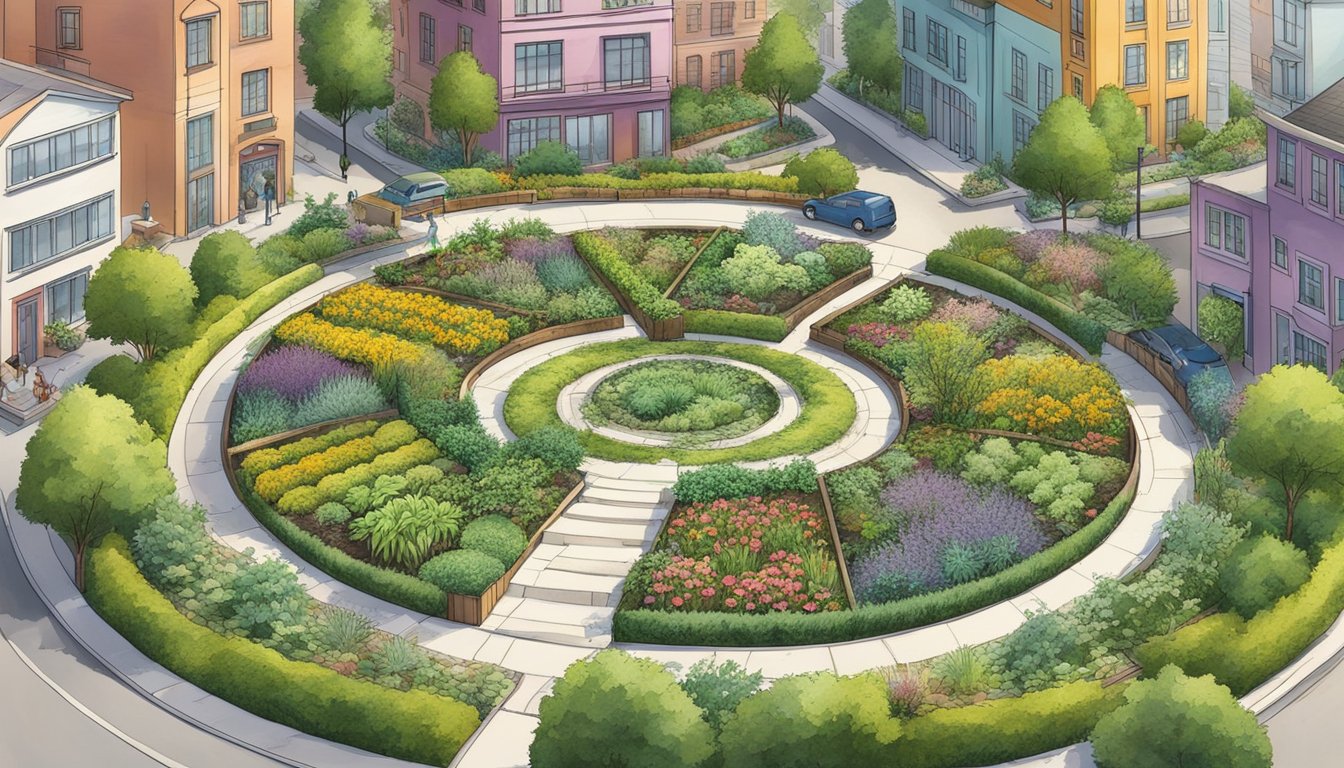
The history of mandala gardens can be traced back to various spiritual traditions where they serve as tools for meditation and reflection. In garden design, this translates to creating a serene and spiritually nourishing space that can help to promote relaxation and stress reduction. Careful plant selection and placement within the mandala’s structure are critical to achieving a harmonious balance. Furthermore, the principles of permaculture often inform the creation of mandala gardens, revolving around sustainability and the replication of natural ecosystems. Gardeners may employ companion planting and natural pest control methods, turning their mandala garden into a thriving, self-sustaining system.
Structural features within mandala gardens can include pathways that invite exploration and raised beds that optimize drainage and soil quality. These features not only accentuate the visual appeal of the garden but also serve practical purposes, contributing to the garden’s health and the gardener’s ease of access. Meanwhile, innovations in design techniques continue to push the boundaries of what’s possible, allowing mandala gardens to become educational tools that demonstrate ecological principles and gardening practices. Despite the challenges that may arise, such as space limitations or climate considerations, gardeners can find creative solutions to adapt the mandala concept to their environment.
Key Takeaways
- Mandalas in garden design emphasize harmony, spiritual nourishment, and efficient use of space.
- Sustainable practices from permaculture inform plant selection and natural garden maintenance.
- Structural innovations contribute to both the aesthetic and educational value of mandala gardens.
History and Origin of Mandala Gardens
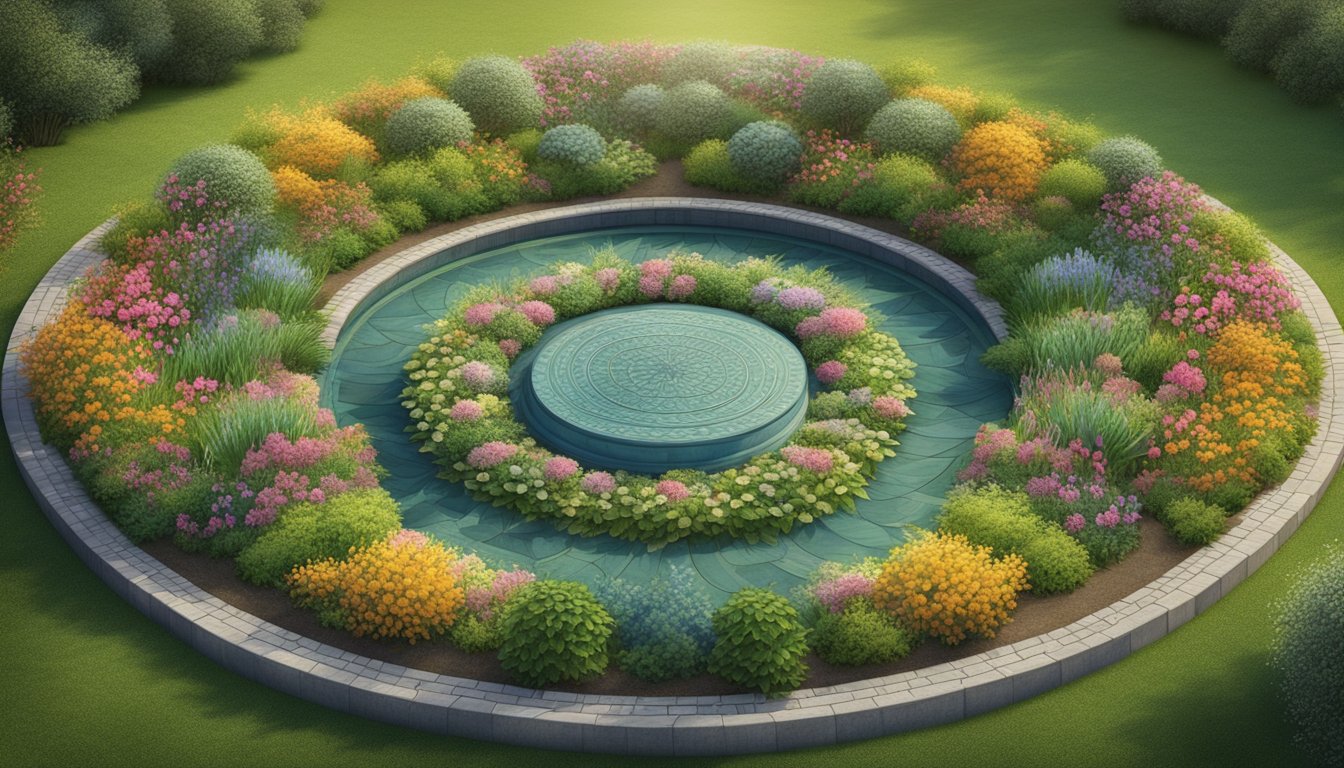
Mandala gardens embody the harmonious principles found in nature, integrating the circular essence of life often seen in patterns of growth and unity.
Cultural Significance of Mandalas
Mandalas have held profound meaning in various cultures throughout history. Originally the word mandala, taken from Sanskrit, signifies “circle”. These circles are not merely shapes but symbols representing the wholeness of life and the universe. In traditions like Hinduism and Buddhism, mandalas serve as spiritual symbols and tools for meditation, reflecting the desire for unity and balance in life. The intricate designs frequently incorporate spirals and geometric patterns that are thought to guide the viewer’s eye inward, towards the center of the circle, illustrating the concept of life spiraling both outwards and inwards – a journey from external diversity to inner unity.
Development of Mandala Garden in Permaculture
Permaculture, a design system for sustainable living and agriculture, has adopted the mandala form for creating highly productive and aesthetic gardens. A pioneer of this concept was Australian ecologist Bill Mollison, who introduced mandala gardens as a part of permaculture design. These gardens often incorporate circular layers and spiral patterns that facilitate efficient plant placement and water movement, resembling the rings of a tree trunk or paths of seeds within a sunflower. The patterns in mandala gardens are intended to mimic nature and promote ecological harmony. In permaculture, every element has a purpose, and mandala gardens are designed so that their components work together synergistically, strengthening the idea of unity between human life and the natural environment. Through their structure, mandala gardens teach the cyclical nature of life’s processes, reinforcing the connection to nature and the concept of life as an ever-changing, yet constant, circle.
Design Principles of Mandala Gardens
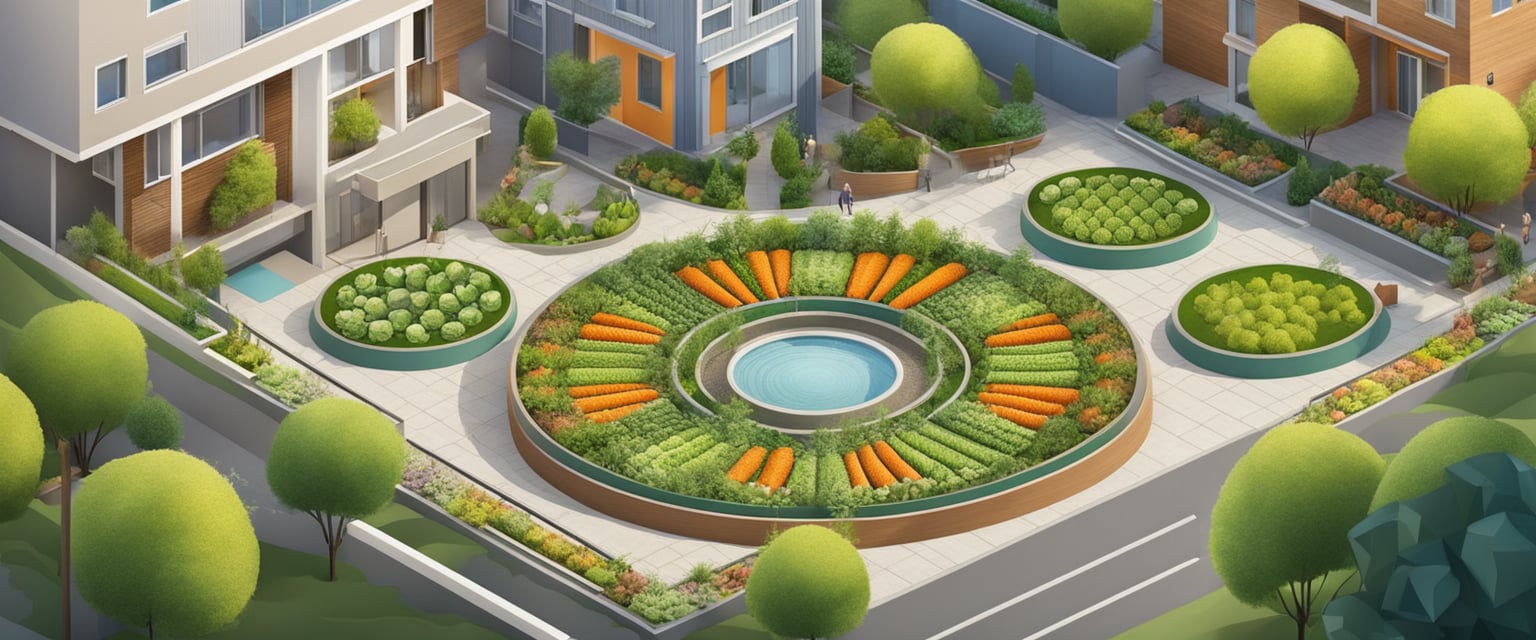
The design principles of mandala gardens integrate symmetry, patterns, and natural elements to create a space that is both beautiful and functional. These principles draw inspiration from the ancient mandala, a symbol of unity and harmony.
Incorporating Circles and Spirals
Circles are a fundamental aspect of mandala garden design, reflecting the natural patterns found in nature. Designers often utilize concentric circles to structure the layout, leading to a soothing visual effect. Spirals, on the other hand, invite movement and energy flow within the garden. These shapes can be created using various plants, pathways, or stone arrangements.
- Circular Design Elements:
- Flower beds: arranged in circular patterns.
- Pathways: curved to guide movement.
Key Elements of Mandala Garden Design
Mandala garden design incorporates several key elements that enhance beauty and functionality. Symmetry is central, with plants and features radiating out from the center. Essential to permaculture principles, designers often choose a variety of herbs, flowers, and vegetable garden plants that benefit the ecosystem:
- Plant Selection:
- Herbs: placed in repeating patterns for ease of harvest.
- Flowers: selected for aesthetics and attracting pollinators.
Zones and Accessibility in Mandala Garden Layout
Establishing zones in a circular garden enhances accessibility and operational efficiency. Pathways are crucial for garden navigation, and their strategic placement ensures that all parts of the garden are easily reachable. The design often features raised beds at arm’s length for convenient access and gardening with minimal strain.
- Accessibility Features:
- Wide paths: for comfortable movement.
- Raised beds: for ease of maintenance and harvesting.
Structural Features of Mandala Gardens
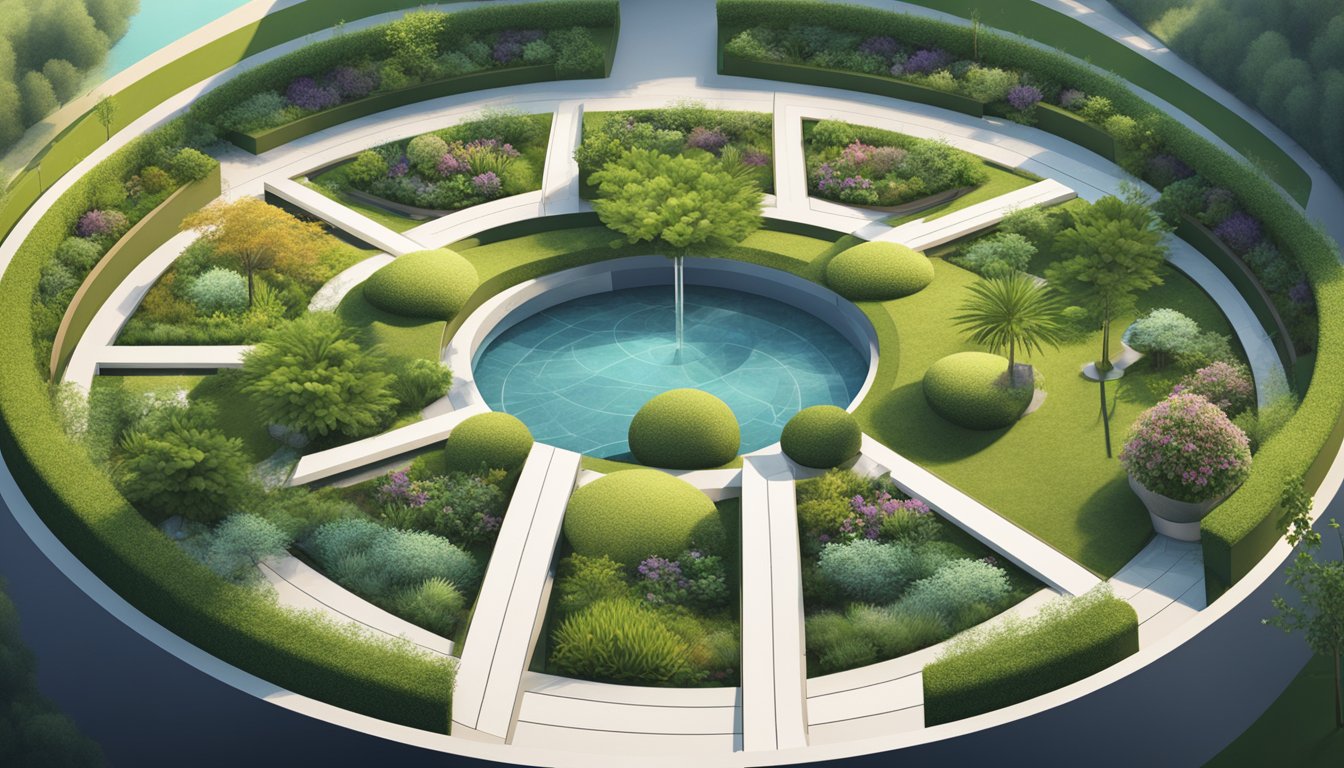
Mandala gardens are visually stunning and functional, employing geometrical patterns that are both pleasing to the eye and beneficial for plant growth. These designs leverage natural materials, creating distinct spaces within the garden.
Paths and Keyhole Beds
In mandala garden designs, paths are both practical walkways and aesthetic elements. They typically radiate outwards like the spokes of a wheel, connecting the external environment to the central heart of the mandala. Keyhole paths, resembling a keyhole when viewed from above, maximize the use of space by allowing access to garden beds without stepping into the growing areas. These paths are often lined with natural elements such as stones, wood, or bricks to define and stabilize them.
Paths
- Visual Appeal: Radiating or spiral patterns
- Function: Easy access to all garden sections
Keyhole Beds
- Design: U-shaped garden beds
- Benefit: Minimized soil compaction and maximized growing area
Central Features and Focal Points
Central features in a mandala garden provide a focal point and can range from a simple arrangement of stones to an elaborate water feature. This central symbol often represents the garden’s sacred space, tying the design to its spiritual roots. A common central feature is a comfortably sized circle that allows visitors to stand or sit and experience the tranquility of the surroundings.
- Central Focal Points
- Examples: Stone arrangement, fire pit, water feature
- Purpose: Spiritual symbolism and visual anchor
Creating Edges and Boundaries with Natural Materials
Boundaries are an essential part of defining the garden’s shape and structure. Natural materials such as stones, wood, or bricks are used to create clear edges around the mandala. These materials are often chosen to complement the surrounding landscape and can also serve as additional seating or as habitats for beneficial insects.
- Edges and Boundaries
- Materials: Stone, brick, or wood borders
- Functions: Separating spaces, enhancing aesthetics, providing habitat
Plant Selection for Mandalas
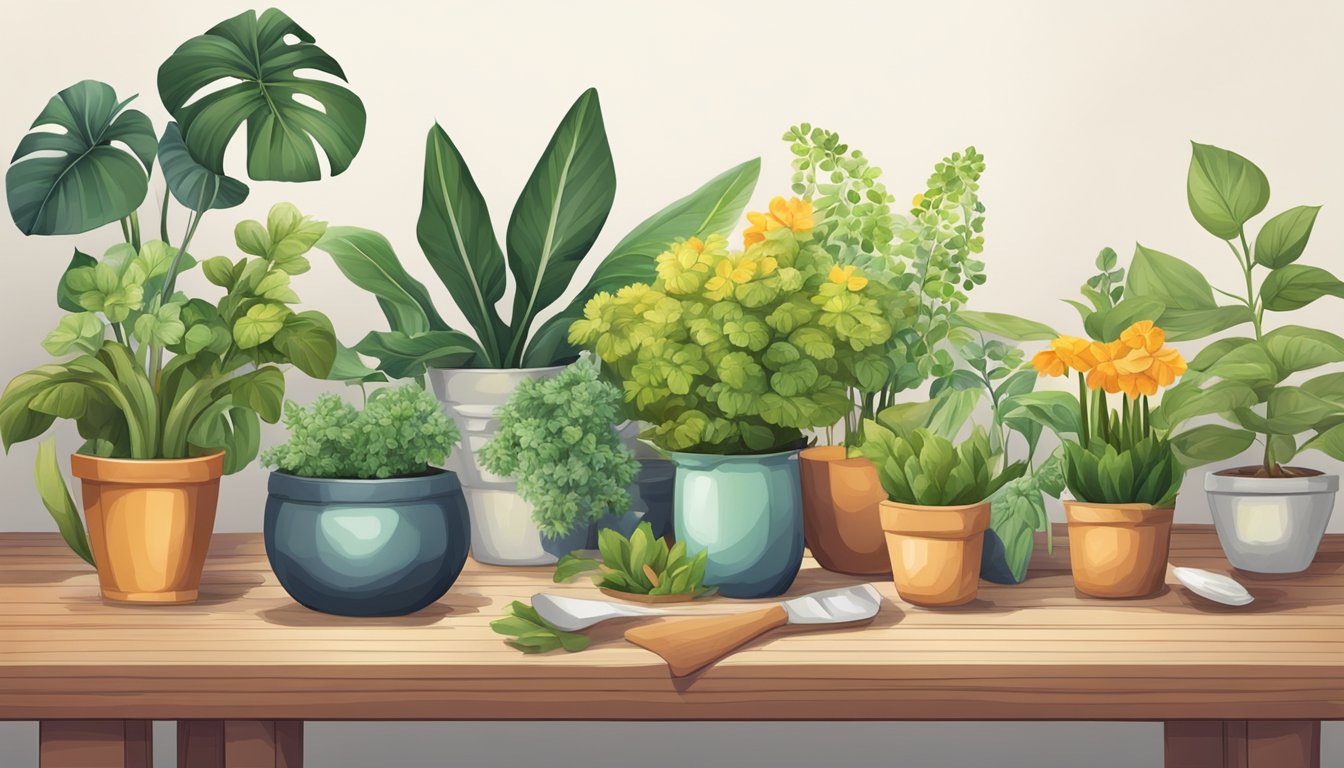
Selecting the right combination of plants is integral to creating a vibrant and productive mandala garden. It involves more than just picking your favorites; it’s about finding harmony between beauty and function, ensuring plants support and enhance each other.
Combining Vegetables, Herbs, and Flowers
Incorporating a mix of vegetables, herbs, and flowers, gardeners can foster a system where each plant type benefits the others. Vegetables such as tomatoes, brassicas, and peppers offer substantial foliage and fruits, while herbs like parsley and lavender contribute fragrant leaves and flowers that attract pollinators. Flowers bring living colour and can deter pests. For example, marigolds may repel nematodes that could otherwise affect tomatoes.
Choosing Plants for Aesthetic Appeal
A mandala garden should be a feast for the eyes with an assortment of plants that provide a range of colors, textures, and forms. Colorful plants should be chosen deliberately to create a visual flow. Lavender with its silvery foliage stands out against the dark green of herbs. The vibrant hues of flowers interspaced with vegetables can create a stunning visual impact.
Layering and Plant Height Variation
Plant height variation is vital for creating an engaging 3D effect. Start with taller plants in the center or back, such as raspberries, blackberries, or tall tomatoes. Then layer down with medium-height plants like strawberries, peppers, or brassicas. Finish with low-growing herbs and flowers in the foreground to provide edges and borders. This layering guides the eye and makes every plant accessible.
Maintaining a Mandala Garden

A well-maintained mandala garden with vibrant plant life relies on thorough soil care, efficient watering, and routine pruning.
Soil Health and Compost Practices
Healthy soil is the foundation of a productive mandala garden, supporting diverse soil life and fostering soil fertility. Gardeners should regularly incorporate compost to nourish the soil, ensuring it’s rich in nutrients. This can involve:
- Creating a compost area within the garden to recycle plant waste.
- Applying compost to the garden beds twice a year to boost beneficial soil biota and maintain soil health.
Watering and Mulching Techniques
Effective watering and mulching are essential for easy maintenance and the garden’s longevity. A mandala garden should have an irrigation plan that considers the needs of all plants. Methods include:
| Technique | Purpose |
|---|---|
| Drip Irrigation | Targets water directly to roots being efficient and water conserving |
| Mulching beds with organic materials like straw or wood chips | Reduces evaporation, retains moisture, suppresses weeds |
Regular Weeding and Pruning
To maintain the garden’s aesthetic and health, regular weeding and pruning are imperative. They
- keep invasive species at bay,
- encourage air circulation,
- facilitate easy maintenance by reducing overcrowding.
Pruning dead or excess growth also stimulates new growth, keeping the garden vibrant and productive.
Spiritual and Therapeutic Aspects

Mandala gardens serve as serene spaces for individuals seeking spiritual growth and emotional healing. They are carefully designed to promote a sense of inner peace and provide an environment conducive to meditation and contemplation.
Mandala Gardens as a Form of Contemplation
The circular design of a mandala garden is rich with symbolism and encourages one to contemplate life’s cyclical nature. The paths within the garden lead the walker through a physical and symbolic journey toward the center, representing unity and personal wholeness. Each step taken along the path can be a step deeper into self-awareness and introspection.
- Paths: Symbolize life’s journey
- Center: Represents unity and personal wholeness
Using the Garden for Meditation and Relaxation
Mandala gardens offer a tranquil setting for meditation and relaxation, crucial for reducing stress and achieving a state of harmony. By engaging the senses through the garden’s beauty, visitors can find a unique form of relaxation.
- Sensory Experience: The colors and fragrances of the plants stimulate a calming effect.
- Seating Areas: These designated spots within the garden allow for prolonged meditation practices.
The alignment of natural elements within a mandala garden is meant to reflect the balance one seeks in their spiritual journey. As they navigate the space, individuals can focus on their breathing and the present moment, further enhancing the meditative experience.
Innovations in Mandala Garden Design

In the realm of Mandala Garden Designs, advancements have focused on sustainability and efficiency. These innovations address specific climate challenges and merge traditional aesthetics with permaculture principles.
Adapting to Climate and Environment
Gardeners are adopting Mandala Garden Designs to various climates by choosing plants that are indigenous to their region, enhancing ecosystem stability and conservation. In areas of intense sunlight, canopy layers are designed to create shade for understory crops, maximizing water retention and reducing evaporation. Designers also incorporate natural windbreaks to protect delicate plants and maintain soil moisture levels.
Hot Arid Climates:
- Use of succulents and drought-resistant plants
- Mulching to preserve soil moisture
Cold Climates:
- Selection of hardy perennials adapted to shorter growing seasons
- Strategic placement of stones to absorb and release heat
Incorporating Modern Permaculture Techniques
Modern permaculture techniques are integral to the latest Mandala Garden Designs. Designers prioritize biodiversity and natural resources, using companion planting to enhance soil health and deter pests naturally. These gardens often feature the integration of water-saving systems like drip irrigation and rainwater catchments, aligning with permaculture’s emphasis on low-impact living.
Soil Fertility:
- Introduction of nitrogen-fixing plants
- Regular addition of organic compost
Pest Control:
- Encouraging beneficial insects through the planting of diverse floral species
- Use of natural barriers such as prickly plants to discourage unwanted creatures
Using Mandala Gardens as an Educational Tool

Mandala gardens offer an engaging way to teach individuals about the interconnected nature of ecosystems and sustainability. They serve as a practical demonstration of permaculture principles and the tapestry of life.
Teaching About Ecosystems and Biodiversity
Mandala gardens, with their intricate designs and segments, can represent different habitats and demonstrate the concept of biodiversity. Each segment of the garden can be planted with different species that might represent varying aspects of an ecosystem, showing how multiple life forms coexist. Students can see firsthand the interdependence of plants, insects, and other wildlife in maintaining a balanced ecosystem. The varied plant species can illustrate the importance of genetic diversity in resilience against pests and diseases.
Promoting Sustainability and Permaculture Principles
Mandala gardens are a testament to sustainability, embodying the core principles of permaculture: care for the earth, care for people, and fair share. By designing these gardens, students learn about sustainable practices such as:
- Soil building: Through composting and mulching techniques.
- Water conservation: Demonstrated by the use of swales or rain gardens which capture and redistribute water.
- Natural pest management: Encouraging natural predators and companion planting to reduce the need for chemical interventions.
These real-life applications reinforce the learning about sustainability and the significance of each element in the permaculture universe. The garden itself becomes both a living classroom and a symbol of balance and harmony with nature.
Creating Your Own Mandala Garden

A Mandala Garden is an eye-catching feature that combines art with functionality, all inspired by the circular and geometric patterns characteristic of mandalas. Designing such a garden involves careful planning to ensure a balance between aesthetics and practicality.
Planning and Preparation
To begin, mapping out the design on paper is crucial. The garden should start from a central point and expand outward in a circular shape. It’s essential to pick a spot that receives adequate sunlight and has the right soil conditions for the plants being considered. Accessibility and visibility from different parts of the property should also factor into the location choice. Considering the overall landscape is vital; the Mandala Garden should enhance the surrounding space, possibly becoming a focal feature.
DIY Tips and Tricks for Building a Mandala Garden
Building a Mandala Garden can be a rewarding DIY project. One can start by marking the center and using strings to outline the circular shape and paths. Raised beds offer a defined structure and can double as seating areas, while spiral paths invite exploration and movement throughout the space. It’s a good opportunity to get creative with stones, pebbles, and sand to create distinctive patterns or define different sections of the garden. Wood can be used for borders or to construct features such as arbors or trellises to add height and visual interest.
Selecting Materials and Plants for Personalization
The choice of materials and plants can reflect an individual’s style while adding to the garden’s beauty. Using a mix of colorful flowers, shrubs, and perennials will ensure that the garden remains vibrant throughout the seasons. For a more functional garden, intermixing vegetables and herbs can turn it into a source of both sustenance and beauty. Materials like wood for edging, stones for paths, and pebbles for decoration are not just practical but also enhance the garden’s aesthetic. Adding elements of shade can create peaceful spots to rest and enjoy the surroundings. Each choice becomes part of a larger experiment in crafting a personalized retreat.
Challenges and Solutions in Mandala Gardening

Mandala garden designs offer a blend of beauty and productivity, yet they present unique challenges. Gardeners can overcome these hurdles with practical strategies for pest control and space management.
Dealing with Pests and Diseases
In any vegetable garden, pests and diseases may threaten plant health. Regular inspection is crucial for early detection. Gardeners may use natural predators, such as ladybugs, to control aphid populations. For fungal diseases, proper air circulation is vital, and using a mulch made of straw can prevent spores from splashing onto plants. A compost tea spray can boost plant immunity and act as a mild fungicide.
Tackling Space and Resource Limitations
Creating a bountiful mandala garden in limited space requires creativity. Utilizing vertical gardening techniques maximizes yield per square foot. For resource management, compost serves as a dual-purpose solution, providing nutrition while reducing waste. Mandala gardens can integrate a compost bin at the center for easy accessibility. Regular weeding and maintenance keep the garden functional and manageable. Mulching pathways conserves water and reduces heavy work by suppressing weeds and retaining soil moisture.
Frequently Asked Questions

Mandala garden designs are visually striking and can be highly beneficial. This section addresses common inquiries relating to their benefits, history, creation, and optimization in garden spaces.
How can one benefit from implementing a mandala garden design?
One can experience both aesthetic pleasure and functional advantages with mandala gardens. They foster a sense of harmony and can enhance garden management by organizing plantings effectively.
What is the historical background of mandala gardens?
Mandala gardens draw inspiration from ancient practices, where mandalas represented the universe and were used in spiritual contexts. Their use in garden design translates these concepts into nature.
What steps are involved in creating a mandala garden?
Creating a mandala garden involves selecting a central focal point and designing symmetrical beds radiating from the center. This typically requires careful planning and consideration of plant choices and pathways.
What are some permaculture principles applicable to mandala gardens?
Permaculture principles like stacking functions and using edge effects are inherent in mandala gardens. They maximize space, promote biodiversity, and ensure each area of the garden serves multiple purposes.
How can vegetable production be optimized through a mandala garden layout?
Optimizing vegetable production in mandala gardens involves strategic placement of plants according to their needs, intercropping, and rotation to encourage healthy growth and high yields within the design layout.
Can you suggest some ideas for integrating mandala patterns into garden beds?
Integrating mandala patterns into garden beds can include using geometric planting schemes, incorporating concentric circles or repeating shapes, and employing color contrasts to highlight the mandala design.



